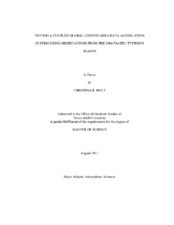| dc.description.abstract | Tropical cyclone (TC) track and intensity forecasts have improved in recent years due to increased model resolution, improved data assimilation, and the rapid increase in the number of routinely assimilated observations over oceans. The data assimilation approach that has received the most attention in recent years is Ensemble Kalman Filtering (EnKF). The most attractive feature of the EnKF is that it uses a fully flow-dependent estimate of the error statistics, which can have important benefits for the analysis of rapidly developing TCs.
We implement the Local Ensemble Transform Kalman Filter algorithm, a variation of the EnKF, on a reduced-resolution version of the National Centers for Environmental Prediction (NCEP) Global Forecast System (GFS) model and the NCEP Regional Spectral Model (RSM) to build a coupled global-limited area analysis/forecast system. This is the first time, to our knowledge, that such a system is used for the analysis and forecast of tropical cyclones. We use data from summer 2004 to study eight tropical cyclones in the Northwest Pacific.
The benchmark data sets that we use to assess the performance of our system are the NCEP Reanalysis and the NCEP Operational GFS analyses from 2004. These benchmark analyses were both obtained by the Statistical Spectral Interpolation, which was the operational data assimilation system of NCEP in 2004. The GFS Operational analysis assimilated a large number of satellite radiance observations in addition to the observations assimilated in our system. All analyses are verified against the Joint Typhoon Warning Center Best Track data set. The errors are calculated for the position and intensity of the TCs.
The global component of the ensemble-based system shows improvement in position analysis over the NCEP Reanalysis, but shows no significant difference from the NCEP operational analysis for most of the storm tracks. The regional component of our system improves position analysis over all the global analyses. The intensity analyses, measured by the minimum sea level pressure, are of similar quality in all of the analyses. Regional deterministic forecasts started from our analyses are generally not significantly different from those started from the GFS operational analysis. On average, the regional experiments performed better for longer than 48 h sea level pressure forecasts, while the global forecast performed better in predicting the position for longer than 48 h. | en |


